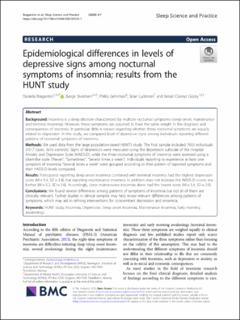| dc.contributor.author | Bragantini, Daniela | |
| dc.contributor.author | Sivertsen, Børge | |
| dc.contributor.author | Gehrman, Philip | |
| dc.contributor.author | Lydersen, Stian | |
| dc.contributor.author | Guzey, Ismail Cuneyt | |
| dc.date.accessioned | 2021-03-03T08:32:53Z | |
| dc.date.available | 2021-03-03T08:32:53Z | |
| dc.date.created | 2021-03-01T07:48:56Z | |
| dc.date.issued | 2020 | |
| dc.identifier.citation | Sleep Science and Practice. 2020, 4 (7), . | en_US |
| dc.identifier.issn | 2398-2683 | |
| dc.identifier.uri | https://hdl.handle.net/11250/2731304 | |
| dc.description.abstract | Background
Insomnia is a sleep disorder characterized by multiple nocturnal symptoms (sleep onset, maintenance and terminal insomnia). However, these symptoms are assumed to have the same weight in the diagnosis and consequences of insomnia. In particular, little is known regarding whether these nocturnal symptoms are equally related to depression. In this study, we compared level of depressive signs among individuals reporting different patterns of nocturnal symptoms of insomnia.
Methods
We used data from the large population-based HUNT3 study. The final sample included 7933 individuals (4317 cases, 3616 controls). Signs of depression were measured using the depression subscale of the Hospital Anxiety and Depression Scale (HADS-D), while the three nocturnal symptoms of insomnia were assessed using a Likert-like scale (“Never”, “Sometimes”, “Several times a week”). Individuals reporting to experience at least one symptom of insomnia “Several times a week” were grouped according to their pattern of reported symptoms and their HADS-D levels compared.
Results
Participants reporting sleep onset insomnia combined with terminal insomnia had the highest depression score (M = 5.4, SD = 3.4), but reporting maintenance insomnia in addition does not increase the HADS-D scores any further (M = 5.2, SD = 3.6). Accordingly, sleep maintenance insomnia alone had the lowest score (M = 3.4, SD = 2.9).
Conclusions
We found several differences among patterns of symptoms of insomnia but not all of them are clinically relevant. Further studies in clinical samples may help reveal relevant differences among patterns of symptoms, which may aid in refining interventions for concomitant depression and insomnia. | en_US |
| dc.language.iso | eng | en_US |
| dc.rights | Navngivelse 4.0 Internasjonal | * |
| dc.rights.uri | http://creativecommons.org/licenses/by/4.0/deed.no | * |
| dc.title | Epidemiological differences in levels of depressive signs among nocturnal symptoms of insomnia; results from the HUNT study | en_US |
| dc.type | Peer reviewed | en_US |
| dc.type | Journal article | en_US |
| dc.description.version | publishedVersion | en_US |
| dc.source.pagenumber | 9 | en_US |
| dc.source.volume | 4 | en_US |
| dc.source.journal | Sleep Science and Practice | en_US |
| dc.source.issue | 7 | en_US |
| dc.identifier.doi | 10.1186/s41606-020-00043-1 | |
| dc.identifier.cristin | 1894348 | |
| dc.relation.project | Samarbeidsorganet mellom Helse Midt-Norge og NTNU: 90061500 | en_US |
| dc.description.localcode | This article is distributed under the terms of the Creative Commons Attribution 4.0 International License (http://creativecommons.org/licenses/by/4.0/), which permits unrestricted use, distribution, and reproduction in any medium, provided you give appropriate credit to the original author(s) and the source, provide a link to the Creative Commons license, and indicate if changes were made. The Creative Commons Public Domain Dedication waiver (http://creativecommons.org/publicdomain/zero/1.0/) applies to the data made available in this article, unless otherwise stated. | en_US |
| cristin.ispublished | true | |
| cristin.fulltext | original | |
| cristin.qualitycode | 1 | |

